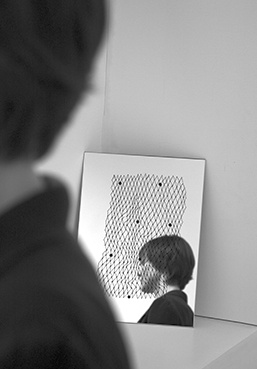Nick Mauss
Not another word for it (2012)
Nick Mauss’ work emerges at the overloaded interstices of fleeting forms, bodies, and ideas, caught on support surfaces and sculptural frames and at the same time released by them. For this year’s Whitney Biennial he recreated a little antechamber that was initially built for the Guerlain perfume company’s headquarters in Paris. Designed by Christian Bérard, a fashion illustrator, set designer, and painter, the walls and ceiling of the room are covered with velvet; they are structured by cotton applications that form architectural embellishments. In his installation Mauss also incorporates works by Andy Warhol and other artists; within the context of the Whitney exhibition he thus creates an intermediate space or passageway whose identity oscillates between installation and display. Maybe it’s because of his preference for only ephemeral relations between idea, form and exhibition context that Mauss seems fascinated also by fragile materials. In drawings, objects and installations, he studies paper and its qualities as a transparent and sculptural medium. Metal, too, appears in Mauss’s art as poised between firmness and fragility: after grounding sheets of plywood with black primer, he coats them with an ultra-thin layer of silver leaf to create paintings that recall a child’s etch-a-sketch, a toy on which the user can write and then efface the writing right away. While some of these works are wall-mounted for presentation, others stand on the floor or lean against a wall, interacting with light, shadows, and the beholder, who spontaneously begins to walk around to observe how the reflexes on the metal surfaces shift. The work Nick Mauss has created for “Texte zur Kunst” builds on these techniques. It catches the moving body in a veil of obstructed reflection. The drawing of a dotted veil, reproduced using silkscreen printing and applied to plate glass, may likewise be set against a wall, laid flat down, or repeatedly repositioned in a room. It then becomes legible not just as a picture, but also as an ambivalent object whose flexible presentation corresponds to the variability of the reflection in the mirror. In formal terms, the silkscreen print derives from a series of drawings “dressed” in black tulle veils. The drawing of the veil, reproduced as a silkscreen on a mirror, is somehow confused in its apparent function as an accessory to see and be seen through. It appears on the mirror as an interference to clear reflection and puts everyone in its sight in a kind of indirect drag.
Nick Mauss, „Not another word for it“, 2012, Silkscreen on mirror, 40 × 29 cm, Edition: 100 + 20 A.P., signed and numbered on the back, each 290,– Euro plus shipping.
Nick Mauss, „Not another word for it“, 2012, Silkscreen on mirror, 40 × 29 cm, Edition: 100 + 20 A.P., signed and numbered on the back, each 290,– Euro plus shipping.

